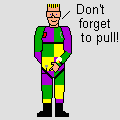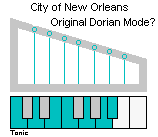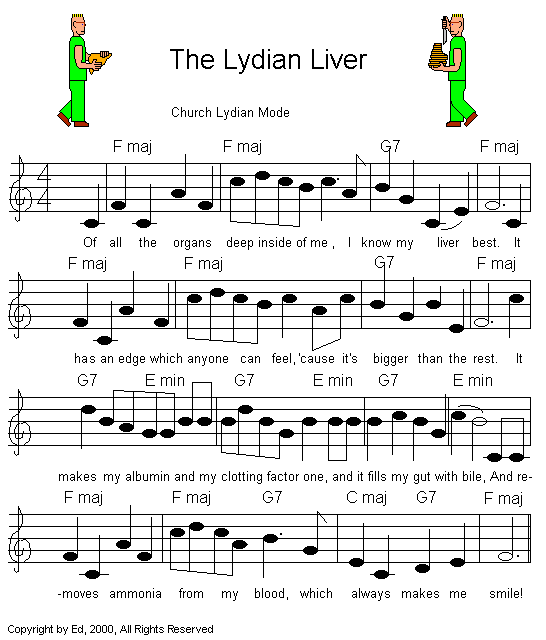 Here are examples of how to tune a seven-string
lyre to play some popular melodies, with
the lowest string arbitrarily set a "C" with the tonic underlined.
Here are examples of how to tune a seven-string
lyre to play some popular melodies, with
the lowest string arbitrarily set a "C" with the tonic underlined.
 The Ancient Musical Modes: What Were They?
The Ancient Musical Modes: What Were They?
I play keyboard and tend to notice scales when I hear music.
I have an idea about the original Greek Modes.
I think that when Plato and Aristotle refer to the various modes, they are referring to various possible ways of tuning a seven-stringed lyre. The names for different tunings were later applied to the various musical scales.
Consider the distance between two pitches, one with twice the frequency of the other. If you subdivide this into twelve equal intervals, you get the equal-tempered chromatic scale. This series of tones includes tones that almost match Pythagoras's diatonic scale and the scales used in most folk music around the world. The equal-tempering allows key shifts. (Mathematics is amazing.)
| C Scale | Frequency | Pythagorean |
| ("Well Tempered") | ("Just Intonation") | |
| C | 1.0000 | 1 |
| C# | 1.0595 | |
| D | 1.1223 | 1 1/8 |
| D# | 1.1892 | |
| E | 1.2599 | 1 1/4 |
| F | 1.3348 | 1 1/3 |
| F# | 1.4142 | |
| G | 1.4983 | 1 1/2 |
| G# | 1.5874 | |
| A | 1.6818 | 1 2/3 |
| A# | 1.7818 | |
| B | 1.8877 | 1 7/8 |
| C | 2.0000 |
Perhaps Pythagoras would have placed the "blue notes" at 1 1/5, 1 3/5, and 1 4/5.
The church modes of medieval and early modern music supposely derive from modes named by the ancient Greeks and described by their writers.
According to the nomenclature of medieval music theorists, who were dealing largely with unchorded plainsong, our natural major is the church "Ionian Mode" (C-D-E-F-G-A-B-C), and our natural minor is the church "Aeolian mode" (C-D-Eb-F-G-Ab-Bb-C).
I became curious about modes when I learned that "Wreck of the Edmund Fitzgerald" and "Scarborough Fair" use the old balladic scale which matches the church "Dorian Mode" (C-D-Eb-F-G-A-Bb-C); I think "Age of Aquarius" does the same, the sea-song "Whay, Hay and Up She Rises", and "Dreadful Wind and Rain" does also.
I used the eerie church "Mixolydian mode" (C-D-E-F-G-A-Bb-C) for my intranet version of "The Pathology Blues", on our quizbank. You can also hear the church "Mixolydian mode" in "The Beat Goes On", "Ritual Fire Dance", "Luck Be a Lady Tonight", the "Star Trek" theme, "Norwegian Wood", "Day Tripper", "Sundown" (Gordon Lightfoot), "Cats in the Cradle", "City of New Orleans" (verse but not chorus), and the theme to "Star Wars". Caedmon recordings used it for the tune for the mystical first song in Yeats's play "The Only Jealousy of Emer".
The other church modes are novelties at best. Some of the old Gregorian chant "Sing my tongue..." seems to be Phrygian mode. There is some of the church "Phrygian mode" in "Fiddler on the Roof", and if the song is fully transposed into the church Phygian mode, it still sounds okay. My own attempt to write a song using the church Phrygian mode was dismal. I wrote a little song in an unabashed church "Lydian mode". The mode itself suggested the subject. Unless you only use the subdominant as a leading tone for the dominant, any melody you write in this "mode" will be unnerving -- the subdominant is equidistant from the lower and upper tonics. A correspondent pointed out that the "Lydian" mode makes up some of the "Jetsons" and "Simpsons" theme. Bartok wrote a short piece called "Lydia" in the Lydian mode to demonstrate. Click here for a here to hear this. Another correspondent ("Piano Pete" from Glasgow, Scotland) tells me that the song Lydia by Faure is written in the Lydian mode; "Hebe" is Phrygian. Yet another of my cyberfriends (Rasa, of Starseed Music) is a musician with a special interest in the emotive power of the modes as we know them today. The group's performance of a piece in the Lydian mode is, I found myself agreeing, "hauntingly beautiful" rather than unnerving.
In the Locrian mode, the dead-center position of the dominant makes this even more unmusical. A music professional told me once that no ethnomusicologist has ever documented a folk tune in what medieval theorists called the "Locrian mode".
I browsed a little in Plato, Aristotle, pseudo-Plutarch's "De Musica", and of course the Oxford History of Music, and came away wondering if the medieval music theorists (Boethius, Gregory the Great, their successors) really meant the same thing as did the Greeks who named the modes.
Today most people (following a scholar named Westphal) tell us that the Greek modes were indeed used as "scales" with the tonic notes being the low-pitched one, just as the church mode theorists say. This seems to be based on statements in Plato and Aristotle that the modes had distinct emotive qualities, as our major and minor scales do.
Another school of thought (that of Munro) claims that for the ancients, the modes were actually keys, i.e., you could play any melody in any mode. If this is true, then the ancient Greeks had either perfect pitch or a standard pitchpipe.
I think people have probably liked similar tunes in different eras. I tried to figure out how the ancient Greeks would have played some of our favorites. Ancient Greek lyres typically had seven strings. (Some Hebrew lyres must have had ten strings -- see Psalm 33.) The system of modes is also called "harmoniae", which meant "fitting" or "tuning". Greek writers on music talk about the normal tuning comprising two tetrachords, i.e., a series of four notes with the lowest and highest separated by a major fourth and sharing the center string. Pythagoras and Terpander are both credited with the idea of having the highest string be an octave of the lowest string.
 Here are examples of how to tune a seven-string
lyre to play some popular melodies, with
the lowest string arbitrarily set a "C" with the tonic underlined.
Here are examples of how to tune a seven-string
lyre to play some popular melodies, with
the lowest string arbitrarily set a "C" with the tonic underlined.
My Darling Clementine: C-E-F-G-A-Bb-C (original Ionian Mode?)
Streets of Loredo: C-E-F-G-A-Bb-C (original Ionian Mode?)
I Saw Three Ships: C-E-F-G-A-Bb-C (original Ionian Mode?)
My Country 'Tis of Thee / God Save the King: C-C#-D#-F-F#-G#-A# (original Locrian mode?)
It's a Wonderful Life: C-Db-Eb-F-Gb-Ab-Bb (original Locrian mode?)
Now at the Dawning of the Day (hymn): C-Db-Eb-F-Gb-Ab-Bb (original Locrian mode?)
Blowin' in the Wind (Bob Dylan): C-Db-Eb-F-Gb-Ab-Bb (original Locrian mode?)
Danny Boy (Verse): C-D-Eb-F-G-Bb-C (original Lydian mode?)
When Johnny Comes Marching Home: C-Eb-F-G-Ab-Bb-C (original Mixolydian mode?)
Rock of Ages: C-Eb-F-G-Ab-Bb-C (original Mixolydian mode?)
Ten Little Indians: C-D-E-F-G-A-C (original Phrygian mode?)
Captain Kangaroo: C-D-E-F-G-A-C (original Phrygian mode?)
Bear Went Over the Mountain: C-D-E-F-G-A-(C) (original Phrygian mode?)
Where Have You Been Billy Boy: C-D-E-F-G-A-C (original Phrygian mode?)
Oh! Susannah!: C-D-E-F-G-A-(C) (original Phrygian mode?)
Aeolian mode?
These are my best guesses about which was which, based on this information:
Can any real musicologist help me?
Links to ancient writers:
In The Republic, Plato claimed that the Ionian and Lydian are "relaxed / soft / drinking" systems, without military use, and should be banned. (It is hard to believe commentators who say that "relaxed" just means the strings are less taut and thus lower-pitched.) Plato also described the two Lydian systems, as expressing sorrow. The Dorian would remain legal for use in war and crisis, and the Phrygian for peace, dignity, temperance, and worship. The discussion indicates that lyres were manufactured in various modes. Plato wanted the government to control popular music by allowing only the manufacture of lyres built for the approved modes. In particular, Plato wanted to ban lyres with lots of strings ("a multiplicity of notes") able to play several different modes.
Aristotle in the "Politics" said that the Mixolydian mode can make you sad and grave. The Dorian mode settles the mind and is gravest and manliest and "avoids extremes". The Phrygian mode inspires enthusiasm and is exciting and emotional and the best for expressing "Bacchic fury". The "relaxed modes", i.e., Lydian and Ionian make people stupid. Complaints about styles of music corrupting young people aren't new.
If we are to take this as evidence that the modes were scales with the tonic note fixed on the lowest pitch, we must explain a few things.
Clement of Alexandria knew the Dorian and Phrygian "harmonies" (tunings) and thought David probably tuned Phrygian-style.
Link is now down: Larry Mysz on the origins. He also doubts that Gregory's "modes" had much to do with those of Aristotle's time.
Some conventional lessions about modes:
Lucy's scales, at U. of Hawaii, cited
sixty named scales from around the world. The link is now down.
Erik van der Meut has a program that shows and plays many scales.
a target=_blank href="http://www.harmonics.com/scales/index.html">Scales database -- work in progress. Very helpful.
Whatever you decide about my idea on the modes... If you like scales, I would enjoy hearing from you.
The standard bugle calls are tritonic (C-E-G-C), since this scale plays easily and naturally on a bugle and these simple sequences are easy to distinguish. The familiar boot camp cadences are major pentatonic (C-D-E-G-A-C) or minor pentatonic (C-D#-F-G-A#-C), as are some intended-to-be-simple tunes like "Old McDonald had a Farm", "Amazing Grace", "Jesus Loves me", "There's a Hole in the Bucket", "The Camptown Races", "Jesus Walked This Lonesome Valley", "Best Day of My Life", and most rock licks and riffs.
Some very old songs ("Pat-A-Pan", "God Rest Ye Merry"), and occasional new ones written to sound elemental ("Neutron Dance" from "Beverly Hills Cop"; "Popcorn"; "Washington Square", "The Good, The Bad, and the Ugly" theme) or simple ("Gilligan's Island" theme) are in the church "Aeolian" natural minor.
Here are some other unconventional octave scales I have noticed, with the tonic at "C":
Noted composer John Carbon and I played keyboard together in high school.
Follow-Up:
April 2005. I had no idea people felt this strongly, or could get so ugly,
about the subject of what exactly Plato and Aristotle were thinking about
when they described
"the modes." Several conservatory types have written, accusing me of
the basest stupidity and ignorance.
However, none of my detractors has explained to me why I'm wrong,
or had disagreed with my little study of what popular tunes go with
what tunings.
Combined with the level of anger directed against me, this makes me think
I'm probably right.
After all, if you only have seven notes on your instrument, what reason do you have
to talk about scales?
My cyberfriend Walt Lysack writes from Manitoba:
My cyberfriend Rom Harre (Distinguished Research Professor,
sychology Department, Georgetown University) write:
Appreciated. Thanks.
My cyberfriend Merrill Humberg explained the difference between equal tempering
and well-tempering in January 2006. (I'd always believed they were the same.)
Scott Crothers reminded me in July 2008 that "all the notes in [a] Mode
need to be represented by a letter name only once in order."
If you have not yet explored "old timey" music from the Appalachians,
you should listen to Jean Ritchie play the
Appalachian dulcimer tuned to
each of the 7 modes. The interesting thing is that
chords can be created only with a couple of the modal tunings on the dulcimer.
The dulcimer fingerb oard is like a guitar fingerboard
with somemissing frets. The other modes were
not novelties in Appalachian tunes. I have stuck to the "autral"
traditional since 1974. Everything I play is "by ear" and
requires "memorizing" 100s of tunes....
I like your explanation of modes the best of all I have read.
The "lyre tunings" idea is reinforced by dulcimer tunings.
I am writing a textbook
for introductory psychology of music... Of course you are
quite right that the modes must have ben
tunings.... I would like to use your choice
of illustrative tunes for the chapter on Greek
and Medieval music.... The sound tracks you added
are charming and may sound like the lyre, except for harmonies!!
No Greek.
"Well-temperament" is a mode that was used before "equal temperament" took hold
in the last century. Well temperament was a few different compromise tunings
(between meantone and equal temperaments) that allowed free modulation throughout all of
the keys but still attempted to keep the "character" of the keys which is completely
lost with equal temperament. Key character used to be a tool that composers used in varying
"well-tempered" tunings to create different moods by writing in "uncommon"
(usually unusuable due to the meantone or pythagorean tunings used in the past)
keys that most would now consider as "out of tune".
July 2006: An internet friend, Andrew Re, who clearly has a good ear,
wrote me to say that Pink Floyd's "Set the controls
for the heart of the sun" on the album "saucerful secrets" is in what is
traditionally called the locrian mode.
"They do a fade out ending because it is really tough / impossible to resolve the
locrian mode without changing to a different mode." I eventually heard the song and he is correct.
Thanks.
Divisions of the Tetrachord -- real music scholarship from Dartmouth

| New visitors to www.pathguy.com reset Jan. 30, 2005: |
scalpel_blade@yahoo.com
No texting or chat messages, please. Ordinary e-mails are welcome.
Play "Phrygian Paraquat Dirge"
Back to Ed's